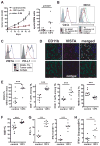VISTA Regulates the Development of Protective Antitumor Immunity
- PMID: 24691994
- PMCID: PMC4116689
- DOI: 10.1158/0008-5472.CAN-13-1506
VISTA Regulates the Development of Protective Antitumor Immunity
Abstract
V-domain Ig suppressor of T-cell activation (VISTA) is a novel negative checkpoint ligand that is homologous to PD-L1 and suppresses T-cell activation. This study demonstrates the multiple mechanisms whereby VISTA relieves negative regulation by hematopoietic cells and enhances protective antitumor immunity. VISTA is highly expressed on myeloid cells and Foxp3(+)CD4(+) regulatory cells, but not on tumor cells within the tumor microenvironment (TME). VISTA monoclonal antibody (mAb) treatment increased the number of tumor-specific T cells in the periphery and enhanced the infiltration, proliferation, and effector function of tumor-reactive T cells within the TME. VISTA blockade altered the suppressive feature of the TME by decreasing the presence of monocytic myeloid-derived suppressor cells and increasing the presence of activated dendritic cells within the tumor microenvironment. In addition, VISTA blockade impaired the suppressive function and reduced the emergence of tumor-specific Foxp3(+)CD4(+) regulatory T cells. Consequently, VISTA mAb administration as a monotherapy significantly suppressed the growth of both transplantable and inducible melanoma. Initial studies explored a combinatorial regimen using VISTA blockade and a peptide-based cancer vaccine with TLR agonists as adjuvants. VISTA blockade synergized with the vaccine to effectively impair the growth of established tumors. Our study therefore establishes a foundation for designing VISTA-targeted approaches either as a monotherapy or in combination with additional immune-targeted strategies for cancer immunotherapy.
©2014 AACR.
Conflict of interest statement
The authors have no additional financial interests.
Conflicts of interest: The authors RJN and LW are involved with ImmuNext Inc and receive financial support for the development of anti-VISTA for immunotherapy.
Figures






References
-
- Zou W, Chen L. Inhibitory B7-family molecules in the tumour microenvironment. Nat Rev Immunol. 2008;8:467–77. - PubMed
-
- van Elsas A, Hurwitz AA, Allison JP. Combination immunotherapy of B16 melanoma using anti-cytotoxic T lymphocyte-associated antigen 4 (CTLA-4) and granulocyte/macrophage colony-stimulating factor (GM-CSF)-producing vaccines induces rejection of subcutaneous and metastatic tumors accompanied by autoimmune depigmentation. J Exp Med. 1999;190:355–66. - PMC - PubMed
-
- Hoos A, Ibrahim R, Korman A, et al. Development of ipilimumab: contribution to a new paradigm for cancer immunotherapy. Semin Oncol. 2010;37:533–46. - PubMed
-
- Calabro L, Danielli R, Sigalotti L, Maio M. Clinical studies with anti-CTLA-4 antibodies in non-melanoma indications. Semin Oncol. 2010;37:460–7. - PubMed
Publication types
MeSH terms
Substances
Grants and funding
LinkOut - more resources
Full Text Sources
Other Literature Sources
Medical
Molecular Biology Databases
Research Materials

